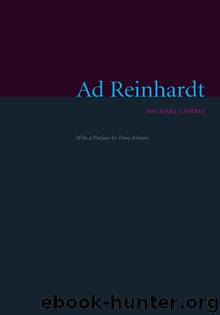Ad Reinhardt by Michael Corris

Author:Michael Corris
Language: eng
Format: epub
TRAILER
Speaking of Reinhardt’s late paintings, the critic Dore Ashton observed that
the ‘black’ is rarely dead black. It has a filmy intonation that ranges from blue-black to ochre-black. The horizontal sections are, except in about two instances, visible thanks to variations in value. In some paintings, there are tones of purple, blue, red-brown, which must be read both in terms of value and chroma . . . A viewer cannot use the same time scale in a Reinhardt as he can in a Kelly, for instance. The low values demand adjustment, and color reveals itself only after contemplation . . . The practical intellect has no function in the apprehension of these paintings.’49
For some of Reinhardt’s very last works the subtle, stunning perceptual impact aptly described by Ashton remains frustratingly unrecoverable. By 1967 Reinhardt had come to discover the limit of the darkening of the ‘black’ painting; effects that were especially vivid and clearly controlled in works dating from 1964 gave way to canvases so dark as to appear to be uninflected monochromes. It is likely that Reinhardt learned this gradually through the experience of restoring, by literally repainting, previously damaged work. Coupled with Reinhardt’s desire to discover how dark a ‘black’ painting could be before it ‘failed’, the process of restoration resulted paradoxically in the darkest works of the series of paintings initiated in 1960. Other factors may have been responsible for some of these very dark paintings, such as Reinhardt’s inability fully to predict how dark the canvas would be once the painting had dried. Presumably, once Reinhardt had achieved a new threshold of ‘invisibility’, he would have continued to reproduce versions of that exemplar according to his established technique. Eventually he would have reached an impasse in the project of ‘black’ painting. Ironically, it would have been the intrinsic limitations of our native perceptual system, rather than a lack of imagination, that would have forced Reinhardt to conclude that he had exhausted this series of work.
There is some evidence to suggest that Reinhardt had begun to face this issue and to consider other means to continue his practice as an artist outside painting. These deliberations may have been hastened by the state of his health in 1967 and the prospect of uninterrupted studio time and travel, thanks to the award of a Guggenheim Foundation Fellowship scheduled to commence in September 1967. Prior to Reinhardt’s death at the end of August 1967, Lippard claims that just days before this date, the artist was on the verge of turning his attention away from painting and towards film, a medium that would have been ideal for the continued exploration of colour light effects through time.50 Reinhardt speculated about the possibility of making a film that would be constructed of a succession of monochrome frames, as a means to reproduce the emergent, animated colour light of his paintings.51 From Reinhardt’s point of view, getting involved with film at this stage in his career would have been a way to validate his long-standing interest in a highly popular medium.
Download
This site does not store any files on its server. We only index and link to content provided by other sites. Please contact the content providers to delete copyright contents if any and email us, we'll remove relevant links or contents immediately.
| Body Art & Tattoo | Calligraphy |
| Ceramics | Conceptual |
| Digital | Erotic |
| Film & Video | Glass |
| Graffiti & Street Art | Illuminations |
| Installations | Mixed Media |
| Mosaic | Prints |
| Public Art | Video Games |
Kathy Andrews Collection by Kathy Andrews(11761)
Thirteen Reasons Why by Jay Asher(8833)
The Red Files by Lee Winter(3388)
How to Do Nothing by Jenny Odell(3263)
The Genius of Japanese Carpentry by Azby Brown(3253)
Stacked Decks by The Rotenberg Collection(2841)
Tattoo Art by Doralba Picerno(2620)
Champions of Illusion by Susana Martinez-Conde & Stephen Macknik(2436)
The Artist's Way Workbook by Cameron Julia(2220)
The Art of Doom by Bethesda(2129)
Calligraphy For Dummies by Jim Bennett(1999)
Creative Character Design by Bryan Tillman(1907)
Botanical Line Drawing by Peggy Dean(1836)
Wall and Piece by Banksy(1793)
The Art of Creative Watercolor by Danielle Donaldson(1785)
One Drawing A Day by Veronica Lawlor(1779)
Art Of Atari by Tim Lapetino(1769)
Pillars of Eternity Guidebook by Obsidian Entertainment(1644)
Happy Hand Lettering by Jen Wagner(1568)
